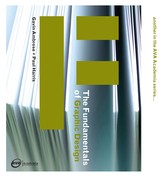
Job No:01077 Title:The fundamentals og Graphic Design
2ND
Proof Page:37
Industrialisation < Te c h n o l o g y > Typogr aphy 37
Fonts for screen
Fonts are now designed specifically for use with
digital applications such as the Internet. Fonts
designed for screen use are created so that they can
be used on a wide range of different systems while
giving the same performance. The existence of
web-safe fonts means website producers can
increase the likelihood that the content will be
displayed as required.
Microsoft produced a standard family of fonts
for Web use. Of these, the following are web-safe
fonts: Arial, Courier New, Georgia, Times New
Roman, Verdana, Trebuchet MS and Lucida Sans.
With only a limited range of web-safe fonts
available, it is probable that a company may not be
able to use its font choices in all arenas. This means
the fonts for its offline communications may be
different to those used for its online communications.
Other limitations of web-safe fonts when used in
print applications is that the serifs can be too fine –
the fonts can be overly broad and they can fill in
with ink when printed.
Glyph switching (flipping)
Glyph switching or flipping is where a digital typeface
contains multiple versions of characters, enabling a
design to create an eclectic look within the
limitations of a single character set. Flipping is an
example of technology presented in a certain way so
as to appear non-technological by including random
differences that add a touch of the accidental, such
as the random printed marks produced by the wear
patterns of letterpress characters. Commands in the
PostScript code refer to a random generator that
makes the character outlines irregular.
The use of glyph switching makes a design
look as though it was not produced using current
technology when technology is actually facilitating
it. There is a certain irony in the fact that the
designers of digital fonts are trying to achieve a
non-uniform effect, while printers using traditional
technology strive to overcome quirks and
irregularities in their finish.
fonts designed
specifically for
screen
The Beowolf typeface was created by Erik van Blokland and
Just van Rossum in 1990 – an example of ‘glyph switching’.
Verdana is a sans serif font specifically designed for
screen use. It is easy to read and is compatible with different
operating systems.
024-071 01077_C1.qxd 8/20/08 1:06 PM Page 37
..................Content has been hidden....................
You can't read the all page of ebook, please click here login for view all page.
